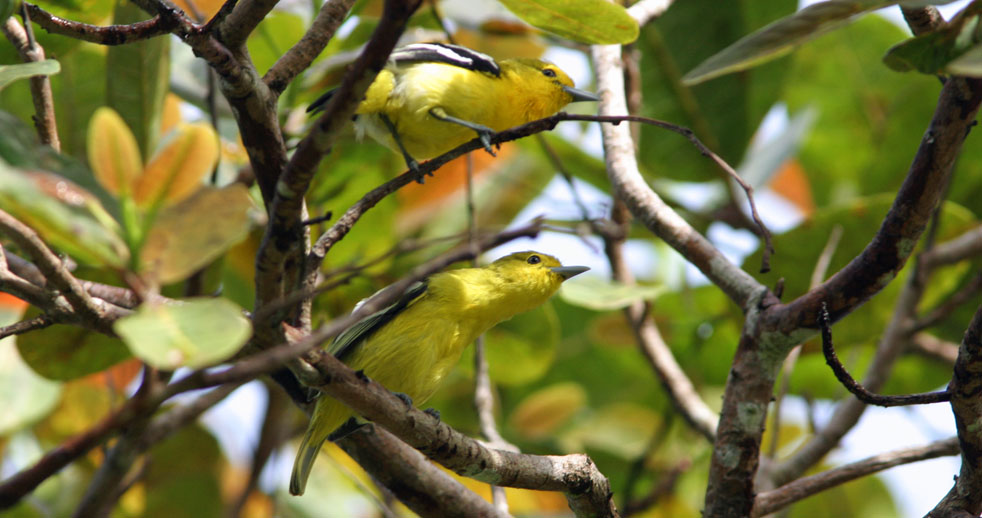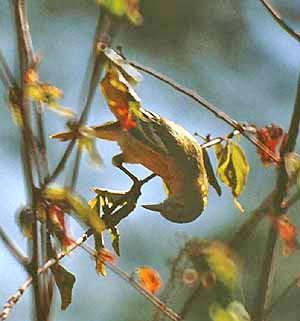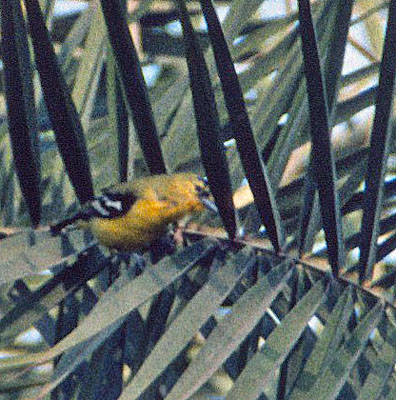| |
IORAS Aegithinidae |
- 4 species in tropical Asia
- DR personal total: 3 species (75%), 1 photo'd
|
 The Ioras are a small group of arboreal passerines found throughout tropical Asia. All four species are in the same genus (Aegithina) and all are comparatively widespread, although some species are scarce and local. Certainly the most often seen is the Common Iora (left and below). It occurs from the Indian subcontinent to Palawan (Philippines), the Greater Sundas, and Java. Ioras tend to forage alone or in pairs in the subcanopy, often eating berries and fruit and well as insect prey. I was reminded of miniature New World orioles is the plumage patterns of some species, but their size and behavior is more similar to New World vireos. The Ioras are a small group of arboreal passerines found throughout tropical Asia. All four species are in the same genus (Aegithina) and all are comparatively widespread, although some species are scarce and local. Certainly the most often seen is the Common Iora (left and below). It occurs from the Indian subcontinent to Palawan (Philippines), the Greater Sundas, and Java. Ioras tend to forage alone or in pairs in the subcanopy, often eating berries and fruit and well as insect prey. I was reminded of miniature New World orioles is the plumage patterns of some species, but their size and behavior is more similar to New World vireos.
Most populations of Common Iora on mainland Asia have black-headed (and often black-backed) males and plain greenish females. In island populations, and some southeast Asian races, have green-capped and green-backed males, such as this male (left) from Palawan in the Philippines [race aequanimis]. Males also have orangey faces and throats. A pair from Palawan is shown below (male uppermost). |
 |
| Common Iora inhabits a multitude of closed-canopy woodlands, from mangroves to gardens to lowland and foothill broadleaf woodlands. It is an brood host of Banded Bay Cuckoo Cacomantis sonneratii in most of range. The other species in the family are White-tailed (or Marshall's) Iora Aegithina nigrolutea [an endemic in thorn scrub of central India with isolated populations in south India and Sri Lanka]; Green Iora Aegithina viridissima [mostly canopy of lowland rainforest on Malay Peninsula and in the Greater Sundas]; and Great Iora Aegithina lafresnayei [southeast Asia]. The latter species is large with a huge bill (for an iora), and lacks wingbars. It is generally limited to evergreen foothill forests on the Malay Peninsula but is also in lowlands farther north. All species are resident; even the populations in Himalayan foothills over-winter (Wells 2005). |
 Ioras were traditionally considered closely related to Leafbirds (Chloropseidae). Like leafbirds, ioras usually forage alone or in pairs in the subcanopy, often eating berries and fruit and well as insect prey (Common Iora, right, of the grren-backed Javan population A. tiphia scapularis). Some literature as recent as the turn of the century continued to place the leafbirds together with the ioras in the same family (e.g., Kennedy et al. 2000). Even the Handbook of Birds of the World series (Wells 2005), whose taxonomic layout was determined years before publication, placed leafbirds and ioras nearly next to each other. However, by then, DNA studies (Sibley & Ahlquist 1990) showed that ioras were not closely related to leafbirds. Molecular studies have shown that the ioras are part of a "corvoid" radiation of largely African and Asian species (Beresford et al. 2005, Fuchs et al. 2012, Aggerbeck 2014). Within this radiation, the position of Aegithinidae is not resolved, but most recently it was considered related to a clade containing both Malaconotidae (Bushshrikes) and Pityriasidae (Bornean Bristlehead; Fuchs et al. 2012, Aggerbeck et al. 2014). In contrast, the genetic evidence found that leafbirds were in the "passeroid radiation," and their nearest relatives were the fairy-bluebirds (Irenidae), and perhaps next closest were sunbirds (Nectariniidae) and flowerpeckers (Dicaeidae; Beresford et al. 2005, Treplin et al. 2008, Johansson et al. 2008). Accordingly, now, in any taxonomy, the ioras are placed a long way away from the leafbirds. Ioras were traditionally considered closely related to Leafbirds (Chloropseidae). Like leafbirds, ioras usually forage alone or in pairs in the subcanopy, often eating berries and fruit and well as insect prey (Common Iora, right, of the grren-backed Javan population A. tiphia scapularis). Some literature as recent as the turn of the century continued to place the leafbirds together with the ioras in the same family (e.g., Kennedy et al. 2000). Even the Handbook of Birds of the World series (Wells 2005), whose taxonomic layout was determined years before publication, placed leafbirds and ioras nearly next to each other. However, by then, DNA studies (Sibley & Ahlquist 1990) showed that ioras were not closely related to leafbirds. Molecular studies have shown that the ioras are part of a "corvoid" radiation of largely African and Asian species (Beresford et al. 2005, Fuchs et al. 2012, Aggerbeck 2014). Within this radiation, the position of Aegithinidae is not resolved, but most recently it was considered related to a clade containing both Malaconotidae (Bushshrikes) and Pityriasidae (Bornean Bristlehead; Fuchs et al. 2012, Aggerbeck et al. 2014). In contrast, the genetic evidence found that leafbirds were in the "passeroid radiation," and their nearest relatives were the fairy-bluebirds (Irenidae), and perhaps next closest were sunbirds (Nectariniidae) and flowerpeckers (Dicaeidae; Beresford et al. 2005, Treplin et al. 2008, Johansson et al. 2008). Accordingly, now, in any taxonomy, the ioras are placed a long way away from the leafbirds. |
 Wells (2005) has some interesting things to say about courtship displays in at least some of the ioras: Wells (2005) has some interesting things to say about courtship displays in at least some of the ioras:
"An undoubted courtship display of the Common Iora, given from a perch in the presence of a female, and after a bot of long-calling vocalizations, involves the male leaning forward, drooping his wings, spreading his tail, and erecting the flank tufts. A second display, and performed also by Marshall's Iora [=White-tailed Iora], is more energetic. In this, the perched male fans out the tail, tips the bill skywards and puffs out the rich yellow throat plumage, then shoots vertically upwards for a metre or more, erecting the body plumage, including that of the flanks, into a "feather ball," and executes a controlled "parachute" drop, descending directly or in a spiral to alight close to the perched female. It is possible that the spiraling descent is assisted by the spread tail. Once the male has landed, the perched display is resumed and the sequence repeated. While perched displays have been recorded widely, the parachute display, curiously, is described only from the Indian Subcontinent. Not a single reports has been found from anywhere in South-east Asia . . . Even within the ornithological literature of the Indian Subcontinent, it is difficult to judge where original description stops and copying-on begins. One radical possibility, yet to be followed-up, is that the parachute display belongs to Marshall's Iora alone."
Obviously, I've not seen any courtship display in an iora, but it sounds delightful. Indeed, I only have one photo of any iorna from India: this shot of Common Iora (left). This iora has a black crown and quite orangey throat and chest. As adult male Common Ioras in India have black backs, I assume this is a young male. |
| |
Photos: The first two photos of Common Iora Aegithina tiphia — of a male and then of a pair —were at Puerto Princesa Subterranean River NP, Palawan, Philippines, on 13 Dec 2005. The third shot of Common Iora was from Baluran NP, east Java, Indonesia, on 15 Sep 1988. The final photo of Common Iora was from Bharatpur, Rajasthan, India, on xx Mar 2001.
All photos © Don Roberson; all rights reserved.
Bibliographic note: There is no "family book" per se, but a good introduction to this family, with some fine photos, is in Wells (2005).
Literature cited:
Aggerbeck, M., J. Fjeldså, L. Christidis, P.H. Fabre, and K.A. Jønsson. 2014. Resolving deep lineage divergences in core corvoid passerine birds supports a proto-Papuan island origin. Molec. Phylog. Evol. 70: 272–285.
Alström, P., P.G. Ericson, U. Olsson, and P. Sundberg. 2006. Phylogeny and classification of the avian superfamily Sylvioidea. Molec. Phylog. Evol. 38: 381–397.
Beresford, P., F.K. Barker, P.G. Ryan, and T.M. Crowe. 2005. African endemics span the tree of songbirds (Passeri): molecular systematics of several evolutionary ‘enigmas.’ Proc. Royal Soc. B (Biol. Sci.) 272: 849–858.
Fuchs, J., M. Irestedt, J. Fjeldså, A. Couloux, E. Pasquet, and R.C. Bowie. 2012. Molecular phylogeny of African bush-shrikes and allies: tracing the biogeographic history of an explosive radiation of corvoid birds. Molec. Phylog. Evol. 64: 93–105.
Johansson, U.S., J. Fjeldså, and R.C. Bowie. 2008b. Phylogenetic relationships within Passerida (Aves: Passeriformes): a review and a new molecular phylogeny based on three nuclear intron markers. Molec. Phylog. Evol. 48: 858–876.
Kennedy, R.S., P.C. Gonzales, E.C. Dickinson, H.C. Miranda, Jr., and T.H. Fisher. 2000. A Guide to the Birds of the Philippines. Oxford Univ. Press, Oxford, U.K.
Sibley, C.G., and J.E. Ahlquist. 1990. Phylogeny and Classification of Birds: a Study of Molecular Evolution. Yale Univ. Press, New Haven, CT.
Treplin, S., R. Siegert, C. Bleidorn, H.S. Thompson, R. Fotso, and R. Tiedemann. 2008. Molecular phylogeny of songbirds (Aves: Passeriformes) and the relative utility of common nuclear marker loci. Cladistics 24: 328–349.
Wells, D.R. 2005. Family Aegithinidae (Ioras), pp. 278–290 in Handbook of the Birds of the World (del Hoyo, J., A. Elliott & D.A. Christie, eds). Vol. 10. Lynx Edicions, Barcelona, Spain.
|
|
|


 Ioras were traditionally considered closely related to Leafbirds (Chloropseidae). Like leafbirds, ioras usually forage alone or in pairs in the subcanopy, often eating berries and fruit and well as insect prey (Common Iora, right, of the grren-backed Javan population A. tiphia scapularis). Some literature as recent as the turn of the century continued to place the leafbirds together with the ioras in the same family (e.g., Kennedy et al. 2000). Even the Handbook of Birds of the World series (Wells 2005), whose taxonomic layout was determined years before publication, placed leafbirds and ioras nearly next to each other. However, by then, DNA studies (Sibley & Ahlquist 1990) showed that ioras were not closely related to leafbirds. Molecular studies have shown that the ioras are part of a "corvoid" radiation of largely African and Asian species (Beresford et al. 2005, Fuchs et al. 2012, Aggerbeck 2014). Within this radiation, the position of Aegithinidae is not resolved, but most recently it was considered related to a clade containing both Malaconotidae (Bushshrikes) and Pityriasidae (Bornean Bristlehead; Fuchs et al. 2012, Aggerbeck et al. 2014). In contrast, the genetic evidence found that leafbirds were in the "passeroid radiation," and their nearest relatives were the fairy-bluebirds (Irenidae), and perhaps next closest were sunbirds (Nectariniidae) and flowerpeckers (Dicaeidae; Beresford et al. 2005, Treplin et al. 2008, Johansson et al. 2008). Accordingly, now, in any taxonomy, the ioras are placed a long way away from the leafbirds.
Ioras were traditionally considered closely related to Leafbirds (Chloropseidae). Like leafbirds, ioras usually forage alone or in pairs in the subcanopy, often eating berries and fruit and well as insect prey (Common Iora, right, of the grren-backed Javan population A. tiphia scapularis). Some literature as recent as the turn of the century continued to place the leafbirds together with the ioras in the same family (e.g., Kennedy et al. 2000). Even the Handbook of Birds of the World series (Wells 2005), whose taxonomic layout was determined years before publication, placed leafbirds and ioras nearly next to each other. However, by then, DNA studies (Sibley & Ahlquist 1990) showed that ioras were not closely related to leafbirds. Molecular studies have shown that the ioras are part of a "corvoid" radiation of largely African and Asian species (Beresford et al. 2005, Fuchs et al. 2012, Aggerbeck 2014). Within this radiation, the position of Aegithinidae is not resolved, but most recently it was considered related to a clade containing both Malaconotidae (Bushshrikes) and Pityriasidae (Bornean Bristlehead; Fuchs et al. 2012, Aggerbeck et al. 2014). In contrast, the genetic evidence found that leafbirds were in the "passeroid radiation," and their nearest relatives were the fairy-bluebirds (Irenidae), and perhaps next closest were sunbirds (Nectariniidae) and flowerpeckers (Dicaeidae; Beresford et al. 2005, Treplin et al. 2008, Johansson et al. 2008). Accordingly, now, in any taxonomy, the ioras are placed a long way away from the leafbirds.  The Ioras are a small group of arboreal passerines found throughout tropical Asia. All four species are in the same genus (Aegithina) and all are comparatively widespread, although some species are scarce and local. Certainly the most often seen is the Common Iora (left and below). It occurs from the Indian subcontinent to Palawan (Philippines), the Greater Sundas, and Java. Ioras tend to forage alone or in pairs in the subcanopy, often eating berries and fruit and well as insect prey. I was reminded of miniature New World orioles is the plumage patterns of some species, but their size and behavior is more similar to New World vireos.
The Ioras are a small group of arboreal passerines found throughout tropical Asia. All four species are in the same genus (Aegithina) and all are comparatively widespread, although some species are scarce and local. Certainly the most often seen is the Common Iora (left and below). It occurs from the Indian subcontinent to Palawan (Philippines), the Greater Sundas, and Java. Ioras tend to forage alone or in pairs in the subcanopy, often eating berries and fruit and well as insect prey. I was reminded of miniature New World orioles is the plumage patterns of some species, but their size and behavior is more similar to New World vireos. Wells (2005) has some interesting things to say about courtship displays in at least some of the ioras:
Wells (2005) has some interesting things to say about courtship displays in at least some of the ioras: